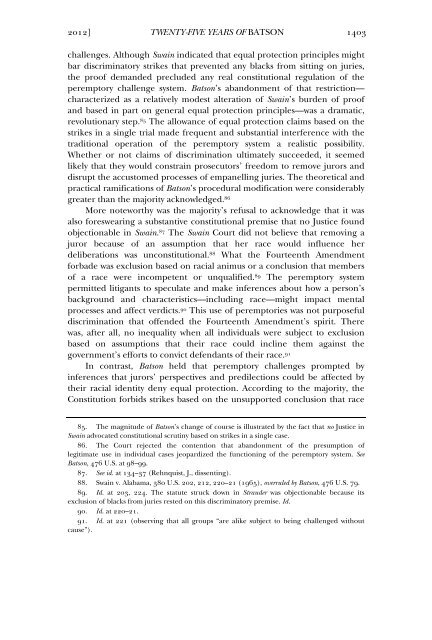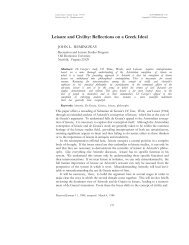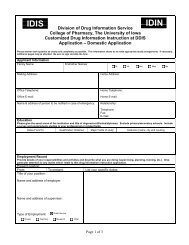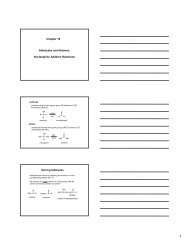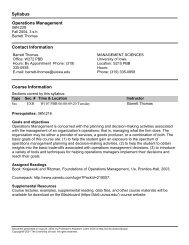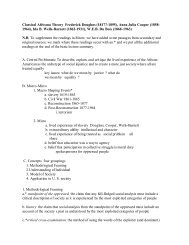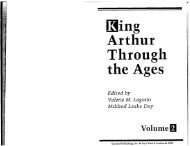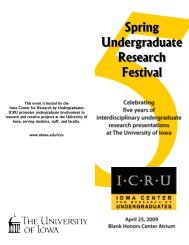Twenty-Five Years of Batson: An Introduction to ... - University of Iowa
Twenty-Five Years of Batson: An Introduction to ... - University of Iowa
Twenty-Five Years of Batson: An Introduction to ... - University of Iowa
Create successful ePaper yourself
Turn your PDF publications into a flip-book with our unique Google optimized e-Paper software.
2012] TWENTY-FIVE YEARS OF BATSON 1403<br />
challenges. Although Swain indicated that equal protection principles might<br />
bar discrimina<strong>to</strong>ry strikes that prevented any blacks from sitting on juries,<br />
the pro<strong>of</strong> demanded precluded any real constitutional regulation <strong>of</strong> the<br />
peremp<strong>to</strong>ry challenge system. <strong>Batson</strong>’s abandonment <strong>of</strong> that restriction—<br />
characterized as a relatively modest alteration <strong>of</strong> Swain’s burden <strong>of</strong> pro<strong>of</strong><br />
and based in part on general equal protection principles—was a dramatic,<br />
revolutionary step. 85 The allowance <strong>of</strong> equal protection claims based on the<br />
strikes in a single trial made frequent and substantial interference with the<br />
traditional operation <strong>of</strong> the peremp<strong>to</strong>ry system a realistic possibility.<br />
Whether or not claims <strong>of</strong> discrimination ultimately succeeded, it seemed<br />
likely that they would constrain prosecu<strong>to</strong>rs’ freedom <strong>to</strong> remove jurors and<br />
disrupt the accus<strong>to</strong>med processes <strong>of</strong> empanelling juries. The theoretical and<br />
practical ramifications <strong>of</strong> <strong>Batson</strong>’s procedural modification were considerably<br />
greater than the majority acknowledged. 86<br />
More noteworthy was the majority’s refusal <strong>to</strong> acknowledge that it was<br />
also foreswearing a substantive constitutional premise that no Justice found<br />
objectionable in Swain. 87 The Swain Court did not believe that removing a<br />
juror because <strong>of</strong> an assumption that her race would influence her<br />
deliberations was unconstitutional. 88 What the Fourteenth Amendment<br />
forbade was exclusion based on racial animus or a conclusion that members<br />
<strong>of</strong> a race were incompetent or unqualified. 89 The peremp<strong>to</strong>ry system<br />
permitted litigants <strong>to</strong> speculate and make inferences about how a person’s<br />
background and characteristics—including race—might impact mental<br />
processes and affect verdicts. 90 This use <strong>of</strong> peremp<strong>to</strong>ries was not purposeful<br />
discrimination that <strong>of</strong>fended the Fourteenth Amendment’s spirit. There<br />
was, after all, no inequality when all individuals were subject <strong>to</strong> exclusion<br />
based on assumptions that their race could incline them against the<br />
government’s efforts <strong>to</strong> convict defendants <strong>of</strong> their race. 91<br />
In contrast, <strong>Batson</strong> held that peremp<strong>to</strong>ry challenges prompted by<br />
inferences that jurors’ perspectives and predilections could be affected by<br />
their racial identity deny equal protection. According <strong>to</strong> the majority, the<br />
Constitution forbids strikes based on the unsupported conclusion that race<br />
85. The magnitude <strong>of</strong> <strong>Batson</strong>’s change <strong>of</strong> course is illustrated by the fact that no Justice in<br />
Swain advocated constitutional scrutiny based on strikes in a single case.<br />
86. The Court rejected the contention that abandonment <strong>of</strong> the presumption <strong>of</strong><br />
legitimate use in individual cases jeopardized the functioning <strong>of</strong> the peremp<strong>to</strong>ry system. See<br />
<strong>Batson</strong>, 476 U.S. at 98–99.<br />
87. See id. at 134–37 (Rehnquist, J., dissenting).<br />
88. Swain v. Alabama, 380 U.S. 202, 212, 220–21 (1965), overruled by <strong>Batson</strong>, 476 U.S. 79.<br />
89. Id. at 203, 224. The statute struck down in Strauder was objectionable because its<br />
exclusion <strong>of</strong> blacks from juries rested on this discrimina<strong>to</strong>ry premise. Id.<br />
90. Id. at 220–21.<br />
91. Id. at 221 (observing that all groups “are alike subject <strong>to</strong> being challenged without<br />
cause”).


